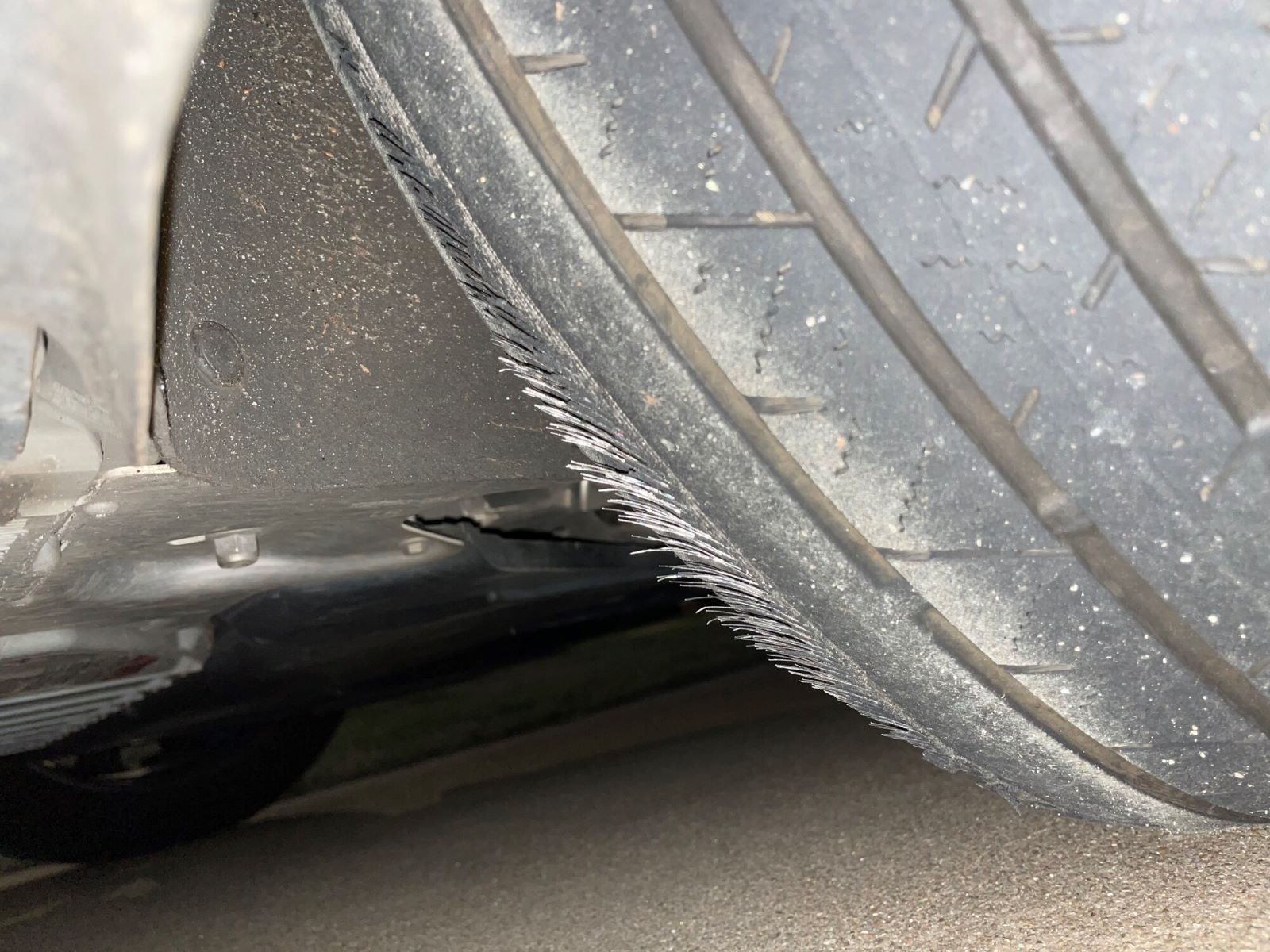Home>Automotive>Shocking! The Surprising Truth About Driving On Tires With Wires Showing


Automotive
Shocking! The Surprising Truth About Driving On Tires With Wires Showing
Published: February 15, 2024
Discover the shocking truth about driving on tires with exposed wires. Learn how to stay safe on the road with this surprising automotive revelation.
(Many of the links in this article redirect to a specific reviewed product. Your purchase of these products through affiliate links helps to generate commission for Regretless.com, at no extra cost. Learn more)
Table of Contents
Introduction
Are you familiar with the phrase "riding on a wire"? It might sound like a metaphorical expression, but in the realm of automotive safety, it's a stark reality that poses significant risks to drivers and passengers alike. The sight of tires with wires showing can be shocking, and rightfully so. It's a clear indication that the tire has exceeded its safe operational limits and is in dire need of replacement. In this article, we will delve into the surprising truth about driving on tires with wires showing, shedding light on the potential dangers, the importance of proactive tire maintenance, and the telltale signs that your tires require immediate attention.
Tires are the unsung heroes of the automotive world, bearing the weight of the vehicle and ensuring a firm grip on the road surface. However, when the protective layers of rubber wear down, the underlying steel wires become exposed, signaling a critical juncture in the tire's lifespan. This visual cue serves as a red flag, indicating that the tire's structural integrity has been compromised, and continued use poses a grave hazard.
As we embark on this exploration, it's crucial to understand that driving on tires with visible wires is not just ill-advised; it's a perilous gamble with potentially catastrophic consequences. The friction generated as the wires make contact with the road can lead to rapid heat buildup, increasing the likelihood of a blowout. Moreover, compromised traction and stability can result in loss of control, especially in adverse weather conditions. These hazards underscore the imperative of maintaining roadworthy tires, free from visible wire exposure.
Join us as we unravel the surprising truth about the perils of driving on tires with wires showing, and discover the indispensable role of proactive tire maintenance in safeguarding not only your vehicle but, more importantly, the lives of those who travel in it. Let's embark on this journey to uncover the hidden dangers and essential precautions that every responsible driver should heed.
Read more: The Surprising Truth About Tires And Rims!
The Dangers of Driving on Tires with Wires Showing
Driving on tires with wires showing poses a myriad of dangers that extend far beyond the inconvenience of a potential flat tire. When the steel wires within a tire become visible, it signifies a critical breach in the tire's structural integrity, rendering it unfit for safe operation. The exposure of these wires is a clear indication that the tire has surpassed its usable lifespan and is no longer capable of providing the necessary traction, stability, and resilience on the road.
One of the most immediate and severe risks associated with driving on tires with visible wires is the heightened potential for a catastrophic blowout. As the tire rotates, the exposed wires are subjected to friction with the road surface, leading to rapid heat buildup. This excessive heat weakens the tire's internal structure, making it increasingly susceptible to a sudden and violent rupture. A blowout at high speeds can result in loss of vehicle control, leading to potentially life-threatening accidents.
Furthermore, compromised traction is a significant concern when driving on tires with visible wires. The diminished grip on the road surface can lead to reduced maneuverability, especially in adverse weather conditions such as rain or snow. This lack of traction increases the likelihood of skidding and loss of control, amplifying the risk of collisions and other road hazards.
In addition to the immediate safety hazards, driving on tires with wires showing can also inflict long-term damage to the vehicle. The compromised tire can exert uneven pressure on the suspension and other components, potentially leading to premature wear and tear. This not only compromises the vehicle's performance but also necessitates costly repairs and replacements.
It's important to recognize that the risks associated with driving on tires with visible wires extend beyond the driver and vehicle. Passengers, pedestrians, and other road users are also vulnerable to the consequences of a tire failure or loss of control, emphasizing the broader impact of neglecting tire maintenance.
In light of these dangers, it is imperative for drivers to remain vigilant and proactive in monitoring the condition of their tires. Regular inspections and timely replacements are essential to mitigate the risks posed by worn-out tires, ensuring the safety of everyone on the road. By acknowledging the perils of driving on tires with wires showing and taking decisive action to address tire wear, drivers can uphold their responsibility to prioritize safety and contribute to a safer driving environment for all.
Why You Should Never Ignore Worn Tires
The condition of your vehicle's tires is a critical factor that directly impacts safety, performance, and overall driving experience. Worn tires, particularly those with visible wires, demand immediate attention and should never be disregarded. Ignoring the signs of tire wear can lead to a host of perilous consequences, making it imperative for drivers to remain vigilant and proactive in addressing this crucial aspect of vehicle maintenance.
First and foremost, worn tires compromise the vehicle's ability to maintain traction and stability on the road. As the tread wears down and the underlying steel wires become exposed, the tire's grip on the road surface diminishes significantly. This reduction in traction can lead to compromised maneuverability, especially in adverse weather conditions such as rain, snow, or icy roads. Without adequate traction, the risk of skidding, loss of control, and potential accidents escalates, posing a grave threat to the driver, passengers, and other road users.
Moreover, worn tires, particularly those with visible wires, are highly susceptible to blowouts. The exposure of steel wires not only weakens the tire's internal structure but also increases the likelihood of rapid heat buildup during operation. This excessive heat can lead to a sudden and catastrophic tire failure, resulting in a blowout. The consequences of a blowout, especially at high speeds, can be devastating, potentially causing loss of vehicle control and endangering lives.
In addition to the immediate safety hazards, ignoring worn tires can lead to long-term damage to the vehicle. Uneven wear and compromised tire integrity can exert undue stress on the suspension and other critical components, accelerating their deterioration and necessitating costly repairs. Furthermore, neglecting worn tires can impact fuel efficiency, as the vehicle's overall performance is compromised when operating on deteriorated or damaged tires.
It's essential to recognize that worn tires are not just a matter of inconvenience or aesthetics; they directly impact the safety and well-being of everyone on the road. By acknowledging the critical importance of maintaining roadworthy tires and promptly addressing signs of wear, drivers can uphold their responsibility to prioritize safety and contribute to a safer driving environment for all. Proactive tire maintenance, including regular inspections and timely replacements, is paramount in safeguarding against the perils of driving on worn tires, ensuring a safer and more secure journey for all road users.
Signs Your Tires Need Immediate Replacement
Identifying the signs that indicate your tires require immediate replacement is crucial for maintaining road safety and preventing potential hazards. Regular inspection of your tires is essential, and being attentive to the following indicators can help you take proactive measures to address tire wear and ensure the continued safety and performance of your vehicle.
-
Visible Wires or Cords: Perhaps the most alarming and unmistakable sign that your tires need immediate replacement is the visibility of steel wires or cords protruding from the tire surface. This indicates that the tire has worn down to a dangerous level, compromising its structural integrity and safety.
-
Uneven Tread Wear: Inspect the tread pattern of your tires regularly. Uneven wear, such as significantly worn edges or a smooth center, can be indicative of alignment issues, over or under-inflation, or suspension problems. Addressing these issues promptly can prolong the life of your tires and enhance overall safety.
-
Bulges or Blisters: Bulges or blisters on the tire sidewall are a clear indication of internal damage. These abnormalities weaken the tire's structure and increase the risk of a sudden blowout. If you notice any bulging or blistering, it's imperative to replace the affected tire immediately.
-
Excessive Cracking: As tires age, the rubber can develop cracks, especially in areas exposed to the elements. These cracks can compromise the tire's integrity and increase the likelihood of a blowout. If you observe extensive cracking on the tire surface, it's a clear signal that replacement is necessary.
-
Low Tread Depth: Tread depth is crucial for maintaining traction and grip on the road. Use a tread depth gauge to measure the depth of the tire grooves. Tread depth below 2/32 of an inch is considered unsafe, indicating the need for immediate replacement.
-
Vibration or Shaking: If you experience unusual vibrations or shaking while driving, it could be a sign of tire imbalance or internal damage. Promptly have your tires inspected to identify the underlying issue and replace any compromised tires.
-
Persistent Loss of Air Pressure: Tires that consistently lose air pressure despite proper inflation may have structural damage or punctures. Continuous air loss compromises safety and fuel efficiency, necessitating immediate attention and potential replacement.
By remaining vigilant and attuned to these signs, drivers can take proactive steps to address tire wear and ensure the safety and reliability of their vehicles. Regular tire inspections, adherence to recommended maintenance schedules, and prompt replacement of worn or damaged tires are essential practices that contribute to a safer driving experience for all road users.
How to Properly Maintain Your Tires
Proper tire maintenance is a fundamental aspect of vehicle ownership that directly impacts safety, performance, and longevity. By implementing proactive measures and adhering to recommended guidelines, drivers can ensure that their tires remain in optimal condition, thereby enhancing road safety and overall driving experience.
-
Regular Inspections: Conducting routine visual inspections of your tires is essential for detecting signs of wear, damage, or underinflation. Check for visible wires, uneven tread wear, bulges, and cracks. Additionally, monitor tire pressure and ensure it aligns with the manufacturer's recommendations.
-
Tire Pressure: Maintaining the correct tire pressure is crucial for both safety and optimal performance. Underinflated tires can lead to increased rolling resistance, reduced fuel efficiency, and uneven wear, while overinflated tires compromise traction and handling. Utilize a reliable pressure gauge to check and adjust tire pressure as needed, including the spare tire.
-
Tire Rotation: Implementing a regular tire rotation schedule promotes even tread wear and extends the overall lifespan of the tires. Front and rear tires experience different wear patterns, and rotating them at recommended intervals ensures balanced wear, enhancing traction and stability.
-
Wheel Alignment: Proper wheel alignment is essential for preserving tire integrity and ensuring vehicle stability. Misaligned wheels can cause uneven tire wear and affect steering responsiveness. Periodic alignment checks and adjustments, especially after hitting potholes or curb impact, are crucial for maintaining optimal tire performance.
-
Balancing: Wheel balancing minimizes vibrations and prevents uneven wear, enhancing overall driving comfort and tire longevity. During routine tire maintenance or replacement, ensure that the wheels are balanced to mitigate potential issues related to imbalance.
-
Tread Depth: Regularly measure the tread depth of your tires to gauge their remaining lifespan and traction capability. Worn-out treads compromise grip and increase the risk of hydroplaning, especially in wet conditions. Replace tires that have worn beyond the recommended tread depth to ensure safe and reliable performance.
-
Avoid Overloading: Adhering to the vehicle's load-carrying capacity is essential for preventing excessive strain on the tires. Overloading can lead to accelerated wear, increased heat buildup, and compromised handling. Refer to the vehicle's manual for the recommended load limits and avoid exceeding them.
By incorporating these tire maintenance practices into your regular vehicle care routine, you can safeguard against premature wear, maintain optimal performance, and contribute to a safer driving environment for yourself and others on the road. Prioritizing tire maintenance not only enhances safety but also preserves the longevity and efficiency of your vehicle's tires, ensuring a smooth and secure driving experience.
Conclusion
In conclusion, the truth about driving on tires with visible wires is a stark reminder of the critical role that proactive tire maintenance plays in ensuring road safety. The dangers associated with worn tires, particularly those with exposed wires, underscore the imperative of remaining vigilant and responsive to the signs of tire wear and damage. The perils of driving on compromised tires extend beyond the immediate safety risks and encompass broader implications for vehicle performance, maintenance costs, and the well-being of all road users.
By recognizing the signs that indicate the need for immediate tire replacement, drivers can take decisive action to mitigate the hazards posed by worn tires. From visible wires and uneven tread wear to bulges, blisters, and excessive cracking, these indicators serve as vital cues for addressing tire wear and upholding safety standards. Moreover, prioritizing regular tire inspections, proper inflation, rotation, alignment, and balancing is instrumental in preserving tire integrity and enhancing overall vehicle performance.
The responsibility of maintaining roadworthy tires extends to every driver, as it directly contributes to a safer and more secure driving environment for all. Ignoring the signs of tire wear not only jeopardizes individual safety but also poses risks to passengers, pedestrians, and fellow motorists. Therefore, embracing a proactive approach to tire maintenance is not just a matter of compliance with safety regulations but a fundamental commitment to prioritizing the well-being of all road users.
As we navigate the roads, let us remain steadfast in our dedication to tire safety, recognizing that the condition of our tires directly impacts our ability to drive safely and responsibly. By heeding the warning signs of tire wear, promptly addressing visible wires, and adhering to recommended maintenance practices, we can collectively contribute to a culture of safety and responsibility on the roads.
In essence, the surprising truth about driving on tires with wires showing serves as a compelling call to action, reminding us of the pivotal role that tire maintenance plays in safeguarding lives and fostering a secure driving environment. Let us embrace this truth as a guiding principle, prioritizing tire safety as an integral part of our commitment to responsible and conscientious driving.














